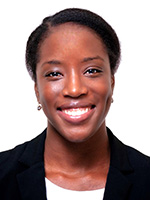Dahlia Mignouna
2020 Temple Bar Scholar Report

The Temple Bar Scholarship was an incredible experience and gave me a deeper knowledge of, and appreciation for, the United Kingdom’s legal system. Over the course of the four-week fellowship, we had the opportunity to learn a remarkable amount, and also had the privilege of meeting many leading members of, as the program puts it, the bench and bar. Each and every person was very generous with their time, and I’ll always be grateful to them and everyone who organized the fellowship for this experience.
The first week of the program was our whirlwind introduction to legal London. Due to the pandemic, we were not able to attend the opening of the legal year. However, we were able to have many meetings and fascinating conversations with the leaders of all four Inns of Court, the Master of the Rolls, the Lord Chief Justice of England and Wales, the Chairman of the National Pro Bono Centre, the Chancellor of the High Court, the President of the Law Society, the President of the Supreme Court, the Head of the Commercial Courts, and the leaders of the Bar Council. Not only did each person answer all our questions, but they were very candid in sharing their thoughts about the positive and exciting aspects of their practice and role, as well as some of the challenges that either the legal profession or the development of law itself was facing. I learned about everything from their efforts to make the legal profession more diverse and representative of the people it serves, to the ways in which judges in the UK were being thoughtful and intentional about ensuring that the law kept up with advances in technology (including the proliferation of cryptocurrency). Each conversation and meeting allowed us to learn about a different aspect of UK law and practice, and it was a highly instructive start to the program.
In addition to our meetings, that first week we were also able to watch a jury deliver a verdict at the Old Bailey (the leading criminal court) and meet with the presiding judge. We also toured the Royal Courts of Justice—a beautiful set of Victorian Gothic style buildings with labyrinthine hallways—and had a fascinating guided tour of the Houses of Parliament.
Our second and third weeks consisted of placements in various barristers’ chambers. I had a wonderful experience at Outer Temple Chambers and Essex Court Chambers, where I had the opportunity to shadow barristers as they drafted their written materials, participated in meetings with clients, and delivered oral presentations in court. I felt very lucky in the breadth and depth of the hearings I was able to attend (particularly given that the pandemic had, for many of the barristers I met, severely curtailed their recent opportunities to attend court in person). Beyond the learning experience, I was so glad to have had the opportunity to get to know the barristers I shadowed, who were unfailingly welcoming.
Our final week of the program was at the Supreme Court of the United Kingdom. Each of us was placed with a Justice, and I had the honor and pleasure of being placed with Lord Stephens. That week was an amazing and once-in-a-lifetime experience: we got to see the Justices in the various parts of their roles, attend oral arguments in several interesting cases, and also meet the fantastic judicial assistants who work for the Justices (and are the equivalent of what we in the United States call judicial law clerks).
One of the aspects of the Supreme Court that I find fascinating is that the Justices of the Supreme Court also sit as the Judicial Committee of the Privy Council. There were smaller aspects of that duality that I found interesting, including the symbolism of changing the flag in the courtroom to the flag of whichever country or nation the case happened to be coming from. But more broadly, I found it quite fascinating that this body ends up hearing so many cases from outside of the UK’s borders, and we were lucky enough to see two privy council cases during our week there. Overall, our last week was an amazing capstone to the month, and I am still deeply humbled by the amount of time that Lord Stephens, and each of the Justices, took to have conversations (and a wonderful dinner) with us, despite their obviously very busy schedules.
Indeed, the hallmark of this entire program has been the unfailing generosity of everyone I met, who spent a great deal of time and energy to allow me to have such a richly rewarding learning experience. It’s one I will not forget.
Dahlia Mignouna is a clerk for Associate Justice Stephen Breyer of the Supreme Court of the United States. Mignouna was born to Togolese parents in Belgium and lived in Belgium, Togo, and Nigeria before coming to the United States at age 10. That upbringing sparked her interest in international issues. In 2012, she graduated magna cum laude from Yale College with a degree in ethics, politics, and economics with a concentration in international development. In 2016, she earned her law degree from Yale Law School, where she was executive editor of the Yale Law Journal. A native French speaker, she first translated for and then represented clients seeking asylum through the Immigration Legal Services Clinic at Yale Law School. After law school, she clerked for Judge Sri Srinivasan of the U.S. Court of Appeals for the DC Circuit and was a litigation associate at the law firm of Munger, Tolles & Olson.